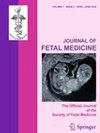染色体微阵列在产前诊断中的实际应用
IF 0.2
Q4 OBSTETRICS & GYNECOLOGY
引用次数: 0
摘要
摘要G带核型分析是检测基因组改变的最常见方法。然而,这无法检测到小于5的基因组变化 兆字节荧光原位杂交(FISH)检测隐性染色体重排的能力超过了常规核型的分辨率。然而,传统的FISH仅针对靶向区域,而染色体微阵列是一种全基因组拷贝数评估技术,分辨率为10-20 kb。在这篇文章中,我们讨论了染色体微阵列750的应用 K至384例连续产前诊断病例。总体诊断率为15.36%,染色体微阵列的额外检测率为3.6%。我们建议将这项技术应用于常规产前诊断,作为产前诊断的第一级测试,并在所有情况下进行后备培养。本文章由计算机程序翻译,如有差异,请以英文原文为准。
Practical Applications of Chromosomal Microarray in Prenatal Diagnosis
Abstract G-banded karyotyping is the most common approach for the detection of genomic alterations. However, this is unable to detect genomic changes of less than 5 Mb. The ability of fluorescence in situ hybridization (FISH) to detect cryptic chromosomal rearrangements exceeds the resolution of routine karyotype. However, conventional FISH is for targeted regions only, whereas the chromosomal microarray is a whole-genome copy number evaluation technique with a resolution of 10 to 20 kb. In this article, we discuss the application of chromosomal microarray 750 K to 384 consecutive prenatal diagnosis cases. Overall diagnostic yield is 15.36%, and chromosomal microarray accounts for a 3.6% additional detection rate. We suggest applying this technique in routine prenatal diagnosis as a first-tier test in prenatal diagnosis along with a backup culture in all cases.
求助全文
通过发布文献求助,成功后即可免费获取论文全文。
去求助
来源期刊

Journal of Fetal Medicine
OBSTETRICS & GYNECOLOGY-
自引率
50.00%
发文量
26
期刊介绍:
Journal of Fetal Medicine is the official journal of the Society of Fetal Medicine affiliated with International Society of Ultrasound in Obstetrics & Gynecology. This is a peer-reviewed international journal featuring articles with special interest to fetal medicine specialists, geneticists and ulstrasonologists. The aim of the journal is to communicate the results of original research in the field of fetal medicine. It includes a variety of articles suitable for clinicians and scientific specialists concerned with diagnosis and therapy of fetal disorders. All articles on health promotion of the fetus are acceptable for publication. The major focus is on highlighting the work that has been carried out in India and other developing countries. It also includes articles written by experts from the West. Types of articles published: - Original research articles related to fetal care and basic research - Review articles - Consensus guidelines for diagnosis and treatment - Case reports - Images in Fetal Medicine - Brief communications
 求助内容:
求助内容: 应助结果提醒方式:
应助结果提醒方式:


